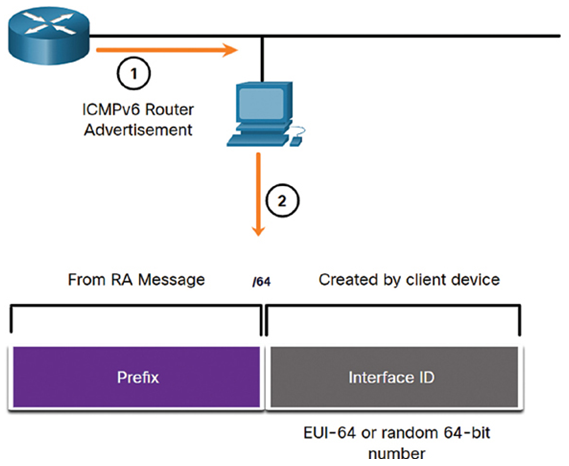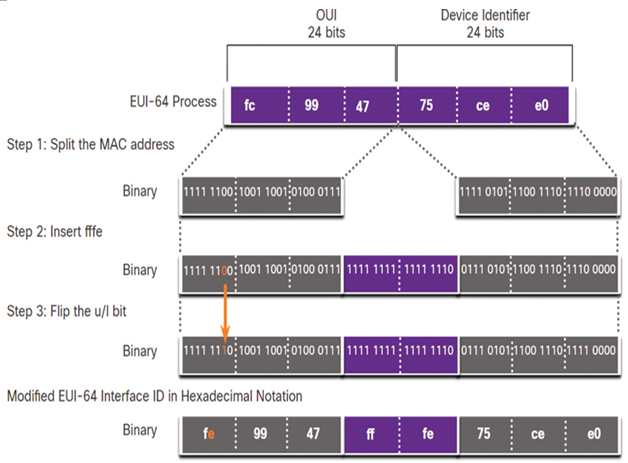EUI-64 Process vs. Randomly Generated (33.3.5)
When the RA message is either SLAAC or SLAAC with stateless DHCPv6, the client must generate its own interface ID. The client knows the prefix portion of the address from the RA message, but must create its own interface ID. The interface ID can be created using the EUI-64 process or a randomly generated 64-bit number, as shown in Figure 33-14.

Figure 33-14 Dynamically Creating an Interface ID
1. The router sends an RA message.
2. The PC uses the prefix in the RA message and uses either EUI-64 or a random 64-bit number to generate an interface ID.
IEEE defined the Extended Unique Identifier (EUI) or modified EUI-64 process. This process uses the 48-bit Ethernet MAC address of a client, and inserts another 16 bits in the middle of the 48-bit MAC address to create a 64-bit interface ID.
Ethernet MAC addresses are usually represented in hexadecimal and are made up of two parts:
• Organizationally Unique Identifier (OUI)—The OUI is a 24-bit (six hexadecimal digits) vendor code assigned by IEEE.
• Device Identifier—The device identifier is a unique 24-bit (six hexadecimal digits) value within a common OUI.
An EUI-64 Interface ID is represented in binary and is made up of three parts:
• 24-bit OUI from the client MAC address, but the 7th bit (the Universally/Locally [U/L] bit) is reversed. This means that if the 7th bit is a 0, it becomes a 1, and vice versa.
• The inserted 16-bit value fffe (in hexadecimal).
• 24-bit Device Identifier from the client MAC address.
The EUI-64 process is illustrated in Figure 33-15, using the R1 GigabitEthernet MAC address of fc99:4775:cee0.

Figure 33-15 The EUI-64 Process
Step 1. Divide the MAC address between the OUI and device identifier.
Step 2. Insert the hexadecimal value fffe, which in binary is 1111 1111 1111 1110.
Step 3. Convert the first two hexadecimal values of the OUI to binary and flip the U/L bit (bit 7). In this example, the 0 in bit 7 is changed to a 1.
The result is an EUI-64 generated interface ID of fe99:47ff:fe75:cee0.
Note
The use of the U/L bit and the reasons for reversing its value are discussed in RFC 5342.
The output in Example 33-3 for the ipconfig command shows the IPv6 GUA being dynamically created using SLAAC and the EUI-64 process. An easy way to identify that an address was probably created using EUI-64 is the fffe located in the middle of the interface ID.
The advantage of EUI-64 is that the Ethernet MAC address can be used to determine the interface ID. It also allows network administrators to easily track an IPv6 address to an end device using the unique MAC address. However, this has caused privacy concerns among many users who worried that their packets could be traced to the actual physical computer. Due to these concerns, a randomly generated interface ID may be used instead.
